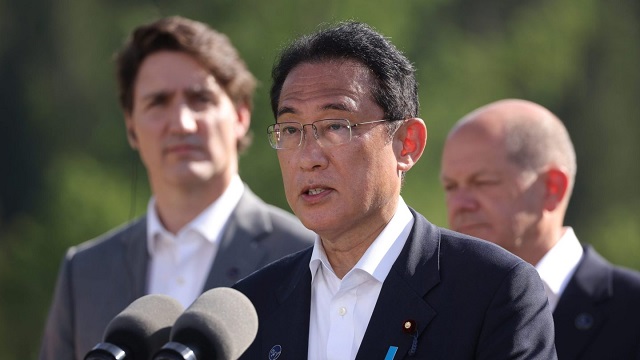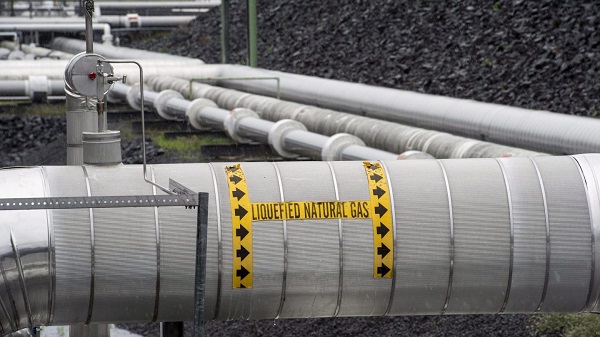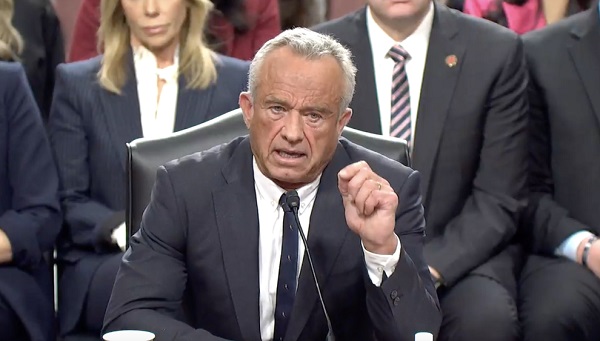Canadian Energy Centre
Canada’s proposed oil and gas emissions cap sends wrong message to allies in Asia: analyst

Prime Minister of Japan Fumio Kishida speaks during the G7 summit at Schloss Elmau, Germany on June 26, 2022 as (L-R) Canadian Prime Minister Justin Trudeau and German Chancellor Olaf Schulz look on. Getty Images photo
From the Canadian Energy Centre
‘We want to fill those pipelines and help Japan and Korea get off Russian supply’
Canada’s proposed oil and gas emissions cap sends a conflicting message to allies in Asia, according to a prominent energy policy analyst.
The plan for the cap – widely seen as a cap on production – is being put together just as Canada nears its first large-scale access to Asia’s growing oil and gas demand, notes Heather Exner-Pirot, a senior fellow with the Macdonald-Laurier Institute.
“Our allies in Asia, particularly Japan and Korea, are waiting for the LNG and the oil,” says Exner-Pirot.
“Everyone knows we only ship to the United States. We haven’t had any real pipeline capacity to the east or to the west. Finally, we’re getting it and now we’re going to curtail production. It makes no sense.”

Heather Exner-Pirot, senior fellow and director of natural resources, energy and environment with the Macdonald-Laurier Institute.
Oil and gas needs in the Asia Pacific region are expected to continue growing through 2030 and 2050, according to the International Energy Agency.
The recently completed Coastal GasLink pipeline is ready to supply natural gas to the LNG Canada export terminal, which is in the final stages of construction and targeted for startup next year.
Meanwhile the Trans Mountain pipeline expansion is weeks away from startup, nearly tripling Canada’s oil export capacity to customers by sea.
The federal plan to cap emissions in 2030 at up to 38 per cent below 2019 levels would require production cuts, according to the Business Council of Canada.
That could threaten world energy security by opening the door to Russia as a bigger supplier instead of Canada, Exner-Pirot says.
“We want to fill those pipelines and help Japan and Korea get off Russian supply and get off OPEC supply, frankly. We want them to have an option,” she says.
“We still haven’t been able to get off Russian oil and gas, and now we want to put in policies that will limit our ability to replace it. Our number one priority should be to replace it.”

A section of the Coastal GasLink pipeline is installed in a challenging section of the Rocky Mountains. Photo courtesy Coastal GasLink
Capping emissions from Canada’s oil and gas sector would come at great economic cost while having negligible impact on the environment, according to analysis by the Montreal Economic Institute (MEI).
“Each time Ottawa forces the Canadian energy sector to contract, it is foreign producers who win,” said MEI public policy analyst Gabriel Giguère.
“Ottawa does not have the means to affect global demand, so reducing local supply will only end up exporting jobs and tax revenues.”
MEI estimates the proposed cap would cost Canada’s economy upwards of $6 billion per year if fully implemented.
Exner-Pirot argues that through initiatives like the Pathways Alliance in the oil sands, Canada’s energy sector already has credible plans reduce emissions and achieve net zero.
“By forcing this abstract date of 2030, you’re making it far more difficult and more expensive, where it will [already] occur within a reasonable timeframe,” she said.
2025 Federal Election
Canada’s pipeline builders ready to get to work

From the Canadian Energy Centre
“We’re focusing on the opportunity that Canada has, perhaps even the obligation”
It was not a call he wanted to make.
In October 2017, Kevin O’Donnell, then chief financial officer of Nisku, Alta.-based Banister Pipelines, got final word that the $16-billion Energy East pipeline was cancelled.
It was his job to pass the news down the line to reach workers who were already in the field.
“We had a crew that was working along the current TC Energy line that was ready for conversion up in Thunder Bay,” said O’Donnell, who is now executive director of the Mississauga, Ont.-based Pipe Line Contractors Association of Canada (PLCAC).
“I took the call, and they said abandon right now. Button up and abandon right now.
“It was truly surreal. It’s tough to tell your foreman, who then tells their lead hands and then you inform the unions that those three or four or five million man-hours that you expected are not going to come to fruition,” he said.

Workers guide a piece of pipe along the Trans Mountain expansion route. Photograph courtesy Trans Mountain Corporation
“They’ve got to find lesser-paying jobs where they’re not honing their craft in the pipeline sector. You’re not making the money; you’re not getting the health and dental coverage that you were getting before.”
O’Donnell estimates that PLCAC represents about 500,000 workers across Canada through the unions it works with.
With the recent completion of the Trans Mountain expansion and Coastal GasLink pipelines – and no big projects like them coming on the books – many are once again out of a job, he said.
It’s frustrating given that this could be what he called a “golden age” for building major energy infrastructure in Canada.
Together, more than 62,000 people were hired to build the Trans Mountain expansion and Coastal GasLink projects, according to company reports.
O’Donnell is particularly interested in a project like Energy East, which would link oil produced in Alberta to consumers in Eastern and Atlantic Canada, then international markets in the offshore beyond.
“I think Energy East or something similar has to happen for millions of reasons,” he said.
“The world’s demanding it. We’ve got the craft [workers], we’ve got the iron ore and we’ve got the steel. We’re talking about a nation where the workers in every province could benefit. They’re ready to build it.”

The “Golden Weld” marked mechanical completion of construction of the Trans Mountain Expansion Project on April 11, 2024. Photo courtesy Trans Mountain Corporation
That eagerness is shared by the Progressive Contractors Association of Canada (PCA), which represents about 170 construction and maintenance employers across the country.
The PCA’s newly launched “Let’s Get Building” advocacy campaign urges all parties in the Canadian federal election run to focus on getting major projects built.
“We’re focusing on the opportunity that Canada has, perhaps even the obligation,” said PCA chief executive Paul de Jong.
“Most of the companies are quite busy irrespective of the pipeline issue right now. But looking at the long term, there’s predictability and long-term strategy that they see missing.”
Top of mind is Ottawa’s Impact Assessment Act (IAA), he said, the federal law that assesses major national projects like pipelines and highways.
In 2023, the Supreme Court of Canada found that the IAA broke the rules of the Canadian constitution.
The court found unconstitutional components including federal overreach into the decision of whether a project requires an impact assessment and whether a project gets final approval to proceed.
Ottawa amended the act in the spring of 2024, but Alberta’s government found the changes didn’t fix the issues and in November launched a new legal challenge against it.
“We’d like to see the next federal administration substantially revisit the Impact Assessment Act,” de Jong said.
“The sooner these nation-building projects get underway, the sooner Canadians reap the rewards through new trading partnerships, good jobs and a more stable economy.”
Canadian Energy Centre
First Nations in Manitoba pushing for LNG exports from Hudson’s Bay

From the Canadian Energy Centre
By Will Gibson
NeeStaNan project would use port location selected by Canadian government more than 100 years ago
Building a port on Hudson’s Bay to ship natural resources harvested across Western Canada to the world has been a long-held dream of Canadian politicians, starting with Sir Wilfred Laurier.
Since 1931, a small deepwater port has operated at Churchill, Manitoba, primarily shipping grain but more recently expanding handling of critical minerals and fertilizers.
A group of 11 First Nations in Manitoba plans to build an additional industrial terminal nearby at Port Nelson to ship liquefied natural gas (LNG) to Europe and potash to Brazil.
Robyn Lore, a director with project backer NeeStaNan, which is Cree for “all of us,” said it makes more sense to ship Canadian LNG to Europe from an Arctic port than it does to send Canadian natural gas all the way to the U.S. Gulf Coast to be exported as LNG to the same place – which is happening today.
“There is absolutely a business case for sending our LNG directly to European markets rather than sending our natural gas down to the Gulf Coast and having them liquefy it and ship it over,” Lore said. “It’s in Canada’s interest to do this.”
Over 100 years ago, the Port Nelson location at the south end of Hudson’s Bay on the Nelson River was the first to be considered for a Canadian Arctic port.
In 1912, a Port Nelson project was selected to proceed rather than a port at Churchill, about 280 kilometres north.
The Port Nelson site was earmarked by federal government engineers as the most cost-effective location for a terminal to ship Canadian resources overseas.
Construction started but was marred by building challenges due to violent winter storms that beached supply ships and badly damaged the dredge used to deepen the waters around the port.
By 1918, the project was abandoned.
In the 1920s, Prime Minister William Lyon MacKenzie King chose Churchill as the new location for a port on Hudson’s Bay, where it was built and continues to operate today between late July and early November when it is not iced in.
Lore sees using modern technology at Port Nelson including dredging or extending a floating wharf to overcome the challenges that stopped the project from proceeding more than a century ago.
He said natural gas could travel to the terminal through a 1,000-kilometre spur line off TC Energy’s Canadian Mainline by using Manitoba Hydro’s existing right of way.
A second option proposes shipping natural gas through Pembina Pipeline’s Alliance system to Regina, where it could be liquefied and shipped by rail to Port Nelson.
The original rail bed to Port Nelson still exists, and about 150 kilometers of track would have to be laid to reach the proposed site, Lore said.
“Our vision is for a rail line that can handle 150-car trains with loads of 120 tonnes per car running at 80 kilometers per hour. That’s doable on the line from Amery to Port Nelson. It makes the economics work for shippers,” said Lore.
Port Nelson could be used around the year because saltwater ice is easier to break through using modern icebreakers than freshwater ice that impacts Churchill between November and May.
Lore, however, is quick to quell the notion NeeStaNan is competing against the existing port.
“We want our project to proceed on its merits and collaborate with other ports for greater efficiency,” he said.
“It makes sense for Manitoba, and it makes sense for Canada, even more than it did for Laurier more than 100 years ago.”
-

 Alberta18 hours ago
Alberta18 hours agoGovernments in Alberta should spur homebuilding amid population explosion
-

 2025 Federal Election2 days ago
2025 Federal Election2 days agoPoilievre Campaigning To Build A Canadian Economic Fortress
-

 Automotive2 days ago
Automotive2 days agoCanadians’ Interest in Buying an EV Falls for Third Year in a Row
-

 conflict1 day ago
conflict1 day agoWhy are the globalists so opposed to Trump’s efforts to make peace in Ukraine?
-

 2025 Federal Election22 hours ago
2025 Federal Election22 hours agoCarney’s budget is worse than Trudeau’s
-

 International18 hours ago
International18 hours agoHistory in the making? Trump, Zelensky hold meeting about Ukraine war in Vatican ahead of Francis’ funeral
-

 Alberta17 hours ago
Alberta17 hours agoLow oil prices could have big consequences for Alberta’s finances
-

 Business17 hours ago
Business17 hours agoIt Took Trump To Get Canada Serious About Free Trade With Itself









